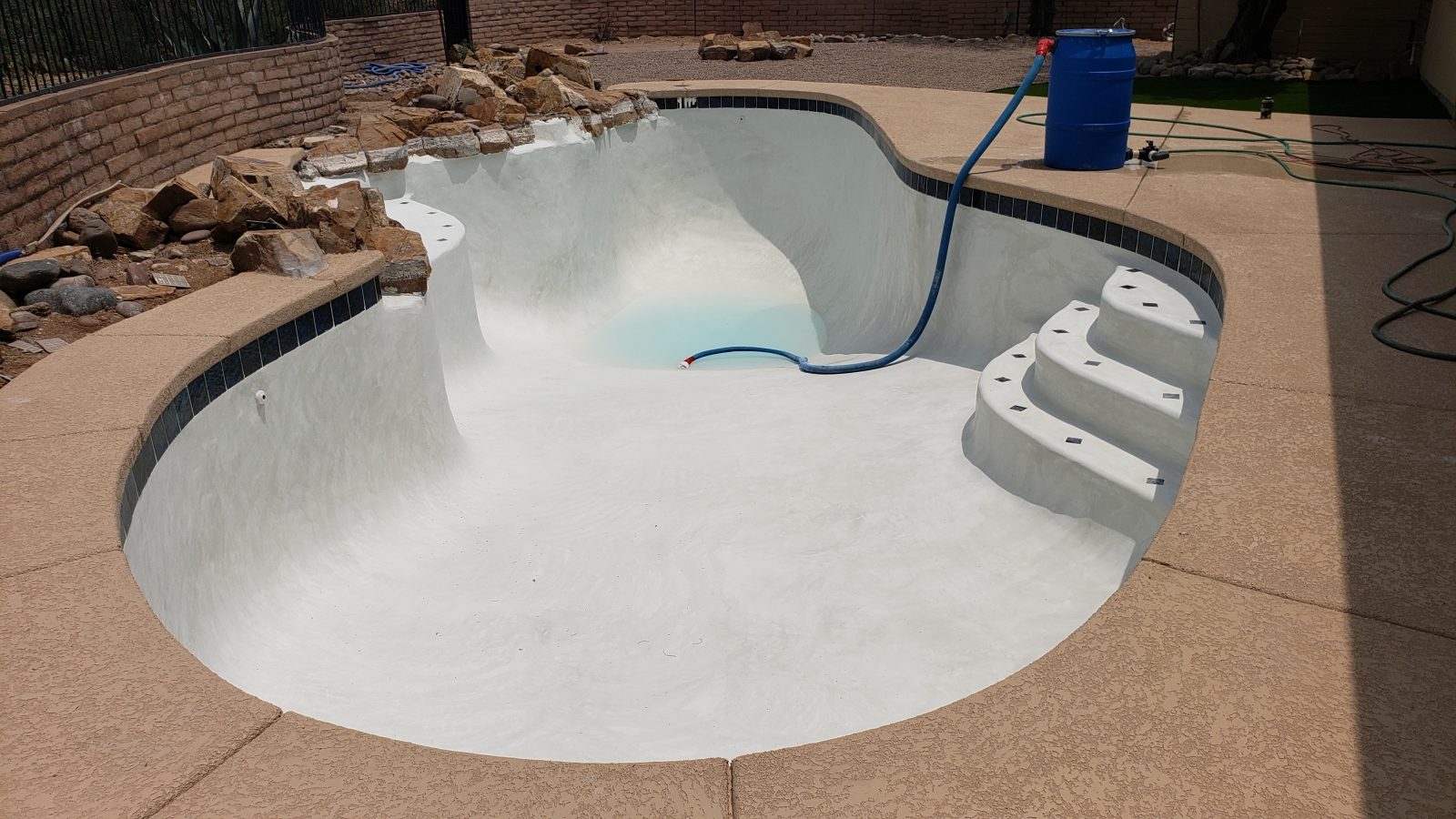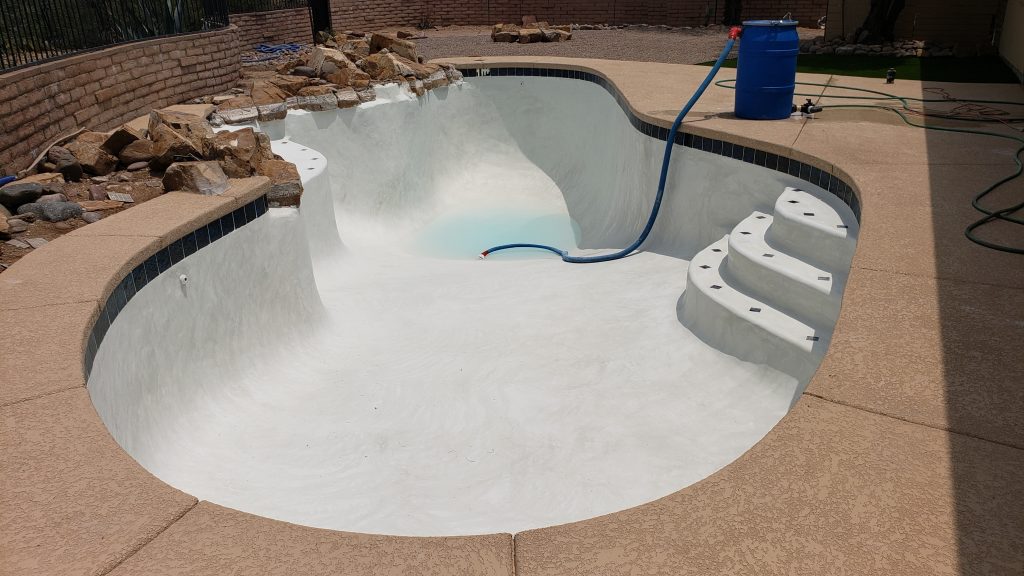The Bicarb Start Up


In the July 14 WaterShapes issue regarding pool startups, Jerry Wallace pointed out that fill or tap water needs to be specially balanced before filling new plaster pools. This article from onBalance LLC follows up on Wallace’s comments with some useful added perspective, and detail regarding common start-up issues, such as preventing plaster dust.
By Kim Skinner, Que Hales & Doug Latta
A good chemical pool startup is the beneficial and vital link between quality plastering workmanship and long-term water balance maintenance. It helps preserve an attractive pool-plaster finish that will last for 20-plus years.
How a startup program deals with and prevents the common problem of “plaster dust” in newly plaster pools is the key. Here’s why.
Plaster “dust” is a calcium carbonate precipitate that usually forms when filling new pools, which then accumulates on the bottom of the pool. Some people have been led to believe the release of calcium from new plaster (which forms the “dust”) is natural and cannot be prevented.
That is incorrect. A quality start-up will minimize or completely prevent plaster dust, which is just one of the benefits.
THE WRONG WAY
While there can be a fair amount of debate about start-up procedures, at onBalance we believe, based on verifiable science, there are, in fact, rights and wrongs. Staying with the plaster dust issue, some technicians in the pool industry go off the deep end by performing “acid startups” as a way to eliminate plaster dust forming in new plaster pools. We believe this is a bad idea and should be abandoned by the industry.
The idea behind this method is simply that making the water extremely acidic by adding many gallons of acid to a newly filled plastered pool, one can dissolve plaster dust. The problem, however, is that the same acid treatment that gets rid of the plaster dust also causes an unseen etched and porous pool plaster surface by dissolving about 40 pounds of calcium from the plaster, depending on the size of the pool.
A Porous Plaster Surface Turns Whitish
When plaster loses some material (calcium hydroxide and other compounds) from the surface, it opens the pores, increases the porosity and allows even balanced pool water to slowly penetrate and dissolve more of the soluble calcium hydroxide beneath the surface. That outcome results in lighter, uneven shades in white plaster, and whitish discoloration of colored plaster.
Likewise, when the plaster in the deep-end bowl of the pool has not been allowed to harden sufficiently and becomes submerged in water too soon, it is likely to become whiter in appearance over time than the rest of the pool that received more time to harden properly.
When deep-end bowls of colored plaster pools turn whitish during the first year, it may be due to being filled too soon or filling with soft aggressive water.
Although an aggressive acid startup may provide a short-term benefit by dissolving dust, exposing the aggregate and making any color more vivid, the long-term impact is not so good. In the months that follow, an etched surface loses its luster, and the plaster surface turns whitish.
The best method to prevent plaster dust, and a host of other potential problems, is to fill newly plastered pools with the right quality of positive Langelier Saturation Index (LSI) water and following one other simple step explained below.
NEW PLASTER SCIENCE
While water balanced with an LSI of 0.0 is good for cured pool plaster, that same balanced water is detrimental to new plaster that is less than two to three weeks old, and especially during the filling of new pools. This simple fact comes as a surprise to some who believe that perfectly balanced water is always the goal.
About 20% of hardened plaster (cement) is a byproduct material known as calcium hydroxide. Calcium hydroxide is relatively soluble and dissolves in 0.0 LSI balanced water. The reality is that filling with 0.0 LSI water is too aggressive for brand-new plaster and leads to a compromised finish due to the dissolving of calcium hydroxide from the plaster surface. This is the source of the calcium that forms the dust.
Also, when calcium hydroxide dissolves and enters the pool water, the pH rises dramatically. Then the calcium hydroxide slowly converts into insoluble calcium carbonate and precipitates out of solution in the form of plaster dust.
For an optimal and durable plaster finish, the calcium hydroxide (and all other plaster components) should remain in the plaster and not be dissolved away.
Good Tap Water
Sometimes, in certain areas of the country, tap water already has a positive LSI with sufficient levels of alkalinity and calcium hardness (combined total of at least 400+ ppm) and can be simply used, as is, to fill new plaster pools without having to do any chemical additions with bicarb or calcium chloride. If that is the case, there is no need to do a special water compounding program. If so, thank your lucky stars! However, the only way to know is to, as we constantly emphasize, pre-test the tap water before filling the pool.
The good news is that filling pools with water that has an LSI of +0.5 or above helps prevent calcium hydroxide from being dissolved from the plaster. Because the calcium hydroxide remains in the plaster, it is then carbonated (converted) into the non-soluble and much harder calcium carbonate. That process takes about two to three weeks. When done properly, the result is that the plaster surface will be harder, denser, smoother, and more stain-resistant than otherwise.
PROPER STEPS
[] Be Patient with new plaster: The first important step is to not fill the pool immediately after final troweling. Waiting a few hours (preferably four hours) to begin filling the pool will allow the fresh plaster in the deep-end bowl (which is troweled and finished last) to harden sufficiently before being submerged in water. Even positive LSI water will dissolve plaster material if it hasn’t been given enough time to hardened (hydrate) sufficiently. [] Fill with the best water: Ensure that the fill water has an LSI of about +0.5 with a minimum alkalinity of 120 ppm. If the tap or fill water doesn’t meet this standard, which is often the case with tap water in this country, it will be too late to balance the water after it has filled the pool. The improper source water will have already done damage by dissolving many pounds of calcium from the plaster. No startup program will undo that damage after the fact.Once the specially balanced tap water begins to fill the pool, fill as quickly as safely possible. Any startup program that doesn’t require the two above conditions doesn’t provide the best care and protection for new plaster. As mentioned above, up to 40 pounds of calcium hydroxide can be dissolved and removed from plaster surfaces when the above steps are not followed, and this is why many plaster finishes, including quartz and pebble, often become unsightly in the few months that follow.
Research by onBalance indicates that that the fill water should have a “combined” total of alkalinity and calcium content of at least 400 ppm minimum, which is how an LSI of +0.5 can be achieved. (A combined total of 500 ppm is the ideal amount).
For example, if the fill water has an alkalinity of 80 ppm and 200 ppm of calcium hardness, raise the alkalinity of the fill water to 200 ppm (prior to using it to fill the pool) to achieve a combined total of 400 ppm (200 TA & 200 CH equals 400 ppm). Having an alkalinity above 120 ppm should provide adequate pH buffering and helps prevent the pH from rising above 8.3.
When the above startup program is followed, there will be little or no plaster dust formation, the pH will be easier to keep and maintain below 8.2 and it will help retain a durable finish and preserve the vivid color in pigmented pool plaster. The Bicarb startup (using sodium bicarbonate, or baking soda to pre-condition the water) has been used successfully for over 40 years by many pool companies.
The Calcium Startup as Promoted by Orenda
The Calcium startup that Orenda Technologies promotes is a good startup program. It also appropriately recommends adjusting the fill water to a positive LSI prior to entering the pool, similar to the program that onBalance began promoting 25 years ago. The difference is that the Orenda program suggests raising the calcium hardness to a high level to achieve a positive LSI instead of raising the alkalinity level.
[] A word of caution: The Calcium Startup is effective when the plaster quality is good. However, when the plaster quality is substandard, plaster dust may still develop, and the pH of the water may rise above 8.3. That is because the alkalinity level may not be high enough to buffer the pH in the event that calcium hydroxide dissolution occurs, which results from poor quality plaster.How to Prevent Craze Cracking
Some plasterers are concerned about noticeable craze cracking developing in their pools, which is why they want to fill the pool immediately after final troweling, which can be detrimental as mentioned previously.
The best way to prevent heavy craze cracking, however, is to not add too much water and calcium chloride when mixing the new plaster, and to not use water while troweling. A low water/cement ratio helps prevent shrinkage. Another beneficial step is to “tent” the pool (and even humidify the air under the tent as needed) when the weather is hot and dry to help prevent shrinkage and cracking of the plaster while the pool is filling.
When the tap water has a low alkalinity (less than 100 ppm), there may not be enough (pH) buffer strength to control and keep the pH down (below 8.3) when poor quality plaster results in some calcium hydroxide releasing into the water. That event can cause the pH to rise above 8.3 and plaster dust generally forms. We suggest that the fill water have an alkalinity above 120 ppm to provide sufficient buffering.
Note: Adding calcium chloride through the start-up barrel increases calcium hardness but does not increase buffer strength in the pool water. Adding sodium bicarbonate does introduce additional buffer.
[] A note about plaster quality: While it is true that a poor pool startup can ruin a high-quality plaster finish, especially an acid startup as mentioned above, it is equally true that poor quality pool plaster and workmanship will negate a good startup program, or in other words, a good startup process cannot fix bad plastering.Poor quality plaster and workmanship can result in the loss of some calcium hydroxide and calcium chloride from the plaster regardless of the startup program. Any loss of plaster material results in greater plaster porosity. (See Sidebar)
In addition, poor quality plaster can result in excessive craze cracking, graying mottling of white plaster, plaster turning whitish in streaks, spots and blotchiness, color fading, calcium nodules, and even some plaster dust. Plastering mistakes that lead to these problems involve excessive water-to-cement ratio, excessive calcium chloride additive, excessive water troweling, and too early filling. A good startup program cannot prevent or alleviate those plaster defects, nor does aggressive water cause any of the above issues.
Poor chemical startups and poor long-term maintenance cause problems such as uniform calcium scaling or uniform etching throughout a pool, and localized damage where non-diluted chemicals come into direct contact with the plaster surface.
Details on how to do a Bicarb startup are found at this link.
The authors are founders of onBalance, an industry organization dedicated to reaserch, education and consulting.









